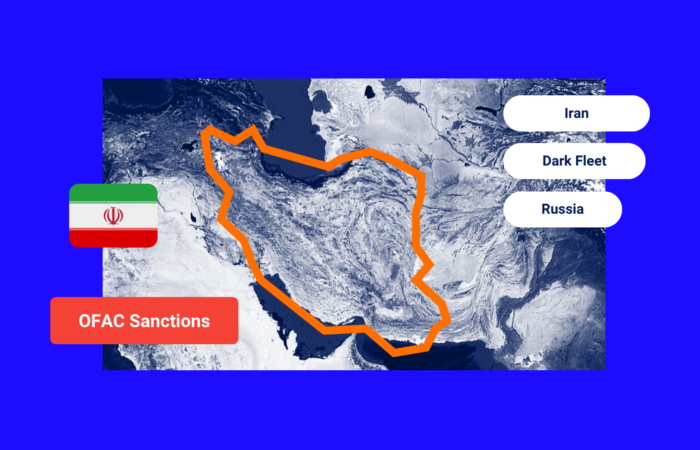OFAC Sanctions VLCCs and the ILA Strike’s Supply Chain Impact

What’s inside?
Hezbollah and its patron Iran continue to attract the attention of regulators. Windward customers knew about six of the nine vessels recently-sanctioned by OFAC back in 2023. Read on to find out which types of tankers they are and which flags they are flying under.
And for the first time in almost five decades, it seems the International Longshoremen’s Association (ILA) union is headed for a strike! (No talks were scheduled at the time of publication). We have all the insights and statistics you need.
New OFAC Sanctions Against IRGC-Hezbollah Related Vessels
- The U.S. Department of State’s Office of Foreign Assets Control (OFAC) announced sanctions against individuals and entities related to Iran’s Revolutionary Guards Corps (IRGC) and Hezbollah on September 25. OFAC also sanctioned nine vessels:
- Eternal Peace, (IMO: 9259745)
- Eternal Success, (IMO: 9307633)
- Eternal 8, (IMO: 9232448)
- Feng Tai, (IMO: 9248473)
- Serene 1, (IMO: 9197832)
- Tiyara, (IMO: 9231224)
- Queen Reem, (IMO: 9141259, formerly known as “Nova”)
- Confidence P, (IMO: 9178044)
- Rival, (IMO: 9117818)
- All vessels are tankers (67% crude oil, 22% oil product tankers, and 11% chemical tankers), most of which are considered very large crude carriers (VLCCs). Additionally, 89% of the vessels are sailing under the flag of Panama and 11% under Iran’s flag.
- Windward’s Maritime AI™ platform shows that six out of the nine were already flagged by Windward as high risk for sanctions evasions in 2023.
- The vessels have shown the following behavioral patterns and risk indicators:
- The vessels conducted a total of 13 location (GNSS) manipulations over the past two years. Almost half of the manipulations occurred in the Arabian Gulf.

ID & location manipulations executed by the nine newly sanctioned vessels, January 2022-September 2024.
All of the transmitting vessels (six out of the nine) engaged in a total of 38 dark activities around the world in the past two years. Most dark activities happened around Singapore and Malaysia, both mentioned in public media sources as a possible Iranian oil smuggling region.

Dark activities from the nine newly sanctioned vessels, January 2022-September 2024.
The ILA Strike’s Impact on the Supply Chain
- For the first time in almost five decades, it seems the International Longshoremen’s Association (ILA) union is headed for a strike! (No talks were scheduled at the time of publication). The labor contract between the union representing 45,000 longshore port workers at East and Gulf ports in the U.S. and the U.S. Maritime Alliance (USMX) employer group expired late Monday.
- One may expect to see a decrease in port calls in these areas, but Windward’s Maritime AI™ platform identified an increase in the number of port calls over the past two weeks.
- There are 403 weekly port calls in the East and Central Coast ports by all cargo vessels, on average. There were 444 port calls from September 15-21, and last week (Sep 22-28), there were 424. This shows 10% and 5% increases, respectively.
- Last month, there were mostly course deviations by cargo vessels in the East Coast, most noticeable near Savannah, New York, and New Orleans, mostly happening on September 26.

Map showing clustering of course deviations by cargo vessels, September 22-28, 2024.
It is likely that since the strike threat became more real, vessels rushed to the possible affected ports, shown by the increase in port calls, so they won’t be stuck after the strike. Then freighters may have started changing their destinations on September 26, as seen by route deviations:
- Industry data indicates that the ports in questions handle more than 68% of all containerized exports in the U.S. and roughly 56% of containerized imports. Windward’s AI-powered insights from our Ocean Freight Visibility solution paint an even more dramatic picture. More than 73% of all shipments to the U.S. are heading towards the East Coast and Gulf of Mexico ports during October 1-31.
- The ripple effects are expected to be massive, costing the U.S. billions each day. According to some estimates, a strike lasting more than seven days could bring back the shortages people experienced during the pandemic. This would eventually lead to capacity and empty container shortages at origin ports in Europe and Asia, spreading the impact to lanes out of those hubs. Additionally, a longer-term strike could lead to pauses in factory production, resulting in shortages during the busiest season of the year, which includes Halloween, Thanksgiving, and Christmas.
For more information check out the full blog post.
Windward’s Red Sea Crisis Awareness Campaign Wins First Place
Why did our Red Sea Crisis Awareness campaign win first place at the 2024 Digital Communication Awards (DCA) in the B2B Communications category?












